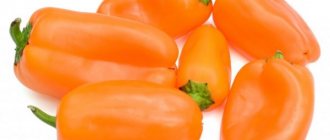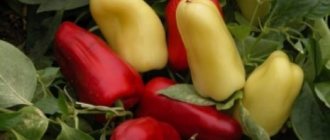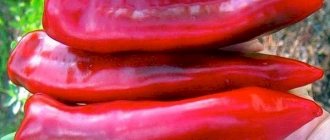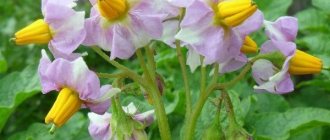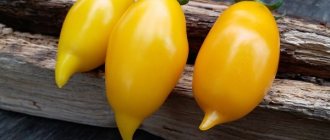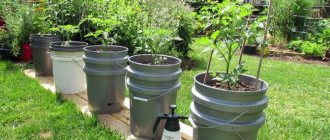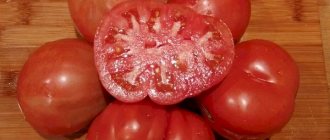Characteristics
| Parameter | Characteristic |
| Variety | Agapovsky |
| Description of fruits | Prism-shaped with a not very smooth glossy skin |
| Fruit weight | Average weight 115-120 g. |
| Color | In technical maturity it is dark green, red in biological maturity. |
| Form | Prismatic |
| Fruit size | Length up to 15 cm |
| Wall thickness | Walls 0.6 -0.7 cm |
| Taste of the fruit | Juicy, sweet |
| Productivity | up to 9.5 kg/ |
| Maturation speed | Early ripening 99-120 days |
| Bush height | Bush collected, height from 60 to 100 cm |
| Pollination type | Self-pollinating |
| Nestedness | 3-4 pcs. |
| Type of ovary formation | Female |
| Transportability and keeping quality | Can withstand transportation well, good shelf life |
| Resistance to adverse conditions | Resistant to growing in unfavorable climates |
| Resistance to diseases and pests | Excellent immunity |
| Should I dive? | Dive required |
| Recommended growing regions | Suitable for all regions of Russia |
| Year of inclusion in the State Register of the Russian Federation | 1995 |
| Originator | Federal Scientific Center for Vegetable Growing of the Moscow Region |
Features of cultivation, planting and care
Sowing pepper seeds for seedlings is carried out 65-70 days before the intended planting of plants in a permanent place. The optimal temperature for seed germination is 26-28°C.
When true leaves appear on the plants, they are transplanted into separate cups with a capacity of 0.3-0.5 liters.
When to plant pepper seedlings in the ground
After the threat of return frosts has passed, the seedlings can be planted in a permanent location. Some people plant in open ground in May, while others only plant under covering material or under film; it all depends on the climatic conditions of your region.
When planting pepper seedlings in the ground for 1 sq. It is recommended to place up to 4 plants of this variety per meter of land, no more. Peppers are planted in the ground without being buried, but in exactly the same way as they grew in cups. Pepper plants, unlike tomatoes, very rarely produce lateral roots, so there is no point in deepening them.
Pepper responds well to watering and fertilizing with complex mineral fertilizers. During the summer, 2-3 feedings are usually done.
Formation of pepper on video
If you grew Agapovsky pepper, please write whether you liked it or not. What was the yield under your climatic conditions? How do you rate the disease resistance of this variety? Briefly describe the advantages and disadvantages of this pepper. If possible, attach a photo of the entire bush or individual fruits you grew to your comment. Thank you!
Your reviews of Agapovsky pepper and additions to the description will help many gardeners evaluate this variety objectively and decide whether it is worth planting or not.
The Agapovsky pepper variety was bred by Russian breeders more than 20 years ago and during this time has gained popularity among many gardeners due to its excellent taste and positive qualities.
The main advantage of the variety is considered to be high productivity and the absence of difficulties in the cultivation process. For this reason, even land owners who do not have sufficient experience will be able to get a good harvest by planting seeds of this type of pepper.
Description of the variety
The Agapovsky variety bush reaches 60 cm in unprotected soil, and 1 m in greenhouses. The dark green large leaves grow very densely. The peppers are drooping and very large. Due to its large size, the shape appears almost square.
The pepper has a red fruit with a dense, slightly wavy, glossy skin and slightly pronounced ribs. The taste of pepper is sweet, the aroma is strong and pleasant.
The thick skin allows the pepper to withstand transportation and storage well. The variety "Agapovsky" has an excellent presentation.
Excellent taste makes it possible to widely use it in cooking:
- lecho;
- stew;
- salads;
- soups;
- stuffing;
- freezing;
- drying;
- canning.
The early ripening of pepper allows it to be grown in regions with short summers: in Siberia, the Urals, and the Far East. However, in these regions the harvest can only be obtained in a greenhouse.
Purpose and storage of pepper
Agapovsky pepper is rich in B vitamins, folic acid, carotene, magnesium, potassium, iron, iodine and zinc. It is useful for vitamin deficiencies. Pepper pulp contains lycopene, which prevents the development of cancer. Antioxidants cleanse the blood, rejuvenate the body, and lower cholesterol levels. Scientists recommend consuming bell pepper fruits for depression, loss of strength, decreased immunity, and insomnia.
Agapovsky pepper is used fresh, as well as for preparing hot dishes and winter preparations. It is stuffed with meat and added to summer salads, soups, borscht and side dishes. Whole fruits are pickled, used to prepare lecho and winter salads, and canned along with other vegetables. Bell peppers will add a touch of sophistication to any dish and decorate them with their bright colors.
Advantages and disadvantages
| pros | Minuses |
| Early maturation | Sun-loving |
| Abundant yield | Moisture-loving |
| Disease resistance | Weak immunity to blossom end rot |
| Meatiness, juiciness | |
| Bright aroma and excellent taste | |
| Possibility to grow in OG and regions with short summers | |
| Transportability | |
| Keeping quality | |
| Marketability | |
| Versatility in cooking | |
| Easy to care for | |
| Self-collection of seeds |
What distinctive properties are Agapovsky sweet pepper rich in?
This variety of sweet pepper is a variety of medium ripeness.
The entire growing season takes no more than four months. The plant has not very large parameters, but regardless of this, the bush is rich in a variety of leaves.
The leaves are large in size and dark greenish in color. The plant is semi-determinate. The bush grows on average up to 90 cm.
The large size of Agapov pepper has a prism-shaped shape. Waves appear on the surface of the crop. Sweet peppers are smooth to the touch. The arrangement of the fruits on the bush is drooping.
The stalk of the crop is not depressed. The culture has up to four nests. The weight of one pepper is about 125 grams. The wall can be up to 9 mm thick. The culture has a very pleasant aroma and tastes good.
The pepper is very juicy and meaty. The color of the fruit during the growing season is dark green. When fully ripe, the pepper turns red. Sweet pepper of this variety contains the following components: dry matter 6.42%, sugar 3.62%, ascorbic acid 206.4 mg per 100 g. raw matter.
The yield of Agapov pepper is 9.3-10.4 kilograms per square meter.
The positive characteristics of Agapovsky pepper are listed below:
- Agapovsky pepper is a variety of medium ripeness.
- The commercial qualities of Agapov pepper are very high.
- A positive quality is the excellent yield of the crop.
- No diseases are scary for this variety of pepper.
- Very good taste and pleasant aroma are good characteristics.
- Agapovsky pepper is used in various culinary directions.
- The compactness of the plant is a good indicator.
The disadvantages of this culture include:
- The plant needs good lighting. If this condition is not met, the ovaries and buds may fall off, and the bush itself may completely wither.
- The crop needs good watering; without this, the plant will wither.
Tips for growing Agapovsky pepper
The agricultural technology of the “Agapovsky” variety differs little from the care of other nightshades. The main difficulty in growing is the moisture-loving nature of pepper and poor shade tolerance. The best harvest is obtained in greenhouses and protected beds.
When to sow seedlings
Seeds for seedlings are sown at the end of February - the first ten days of March. Seeds collected from the previous harvest are suitable for sowing. Before planting, they are soaked for about 2 hours in a solution of potassium permanganate. The seeds are planted in moist soil, slightly buried, and covered with film.
Picking is done with the appearance of the first true leaves. But, if possible, in order not to injure the plant, you can immediately sow the seeds in separate pots.
Seed care requires traditional:
- if the daylight hours are not long enough, then additional lighting is provided;
- moderate watering;
- Feeding is required 2-3 times.
When the seeds sprout
Pepper sprouts appear on the surface 7-10 days after sowing. When the seeds germinate, the film can be removed.
Before being taken into the ground, about a week before, for hardening, the seedlings are placed on a balcony or terrace for a short period of time.
When and at what distance to plant in the ground
At the end of May and beginning of June, seedlings are planted in beds. By this time the bushes should already be covered with 8-10 true leaves. When planting, you should adhere to the 40x60 pattern.
Plants are planted in well-fertilized soil. A third of a glass of ash and a handful of humus are added to each hole. It is also good to mulch the soil.
Ripening period
Pepper "Agapovsky" reaches technical maturity on the hundredth day after sprouting. It takes another three weeks for the fruit to fully ripen.
Watering
The Agapovsky variety is very demanding when it comes to watering. Both overwatering and underwatering have a negative impact on the crop yield.
Before flowering, it is better to water the peppers using the sprinkling method. Thus, they will receive a sufficient amount of moisture, and at the same time the air in the greenhouse will become humid. However, the air in the greenhouse should not stagnate, so it needs to be ventilated more often.
From the beginning of flowering until the formation of the first fruits, bushes especially need watering. If the weather is hot, then they are watered twice a day. In the future, 3-4 times a week will be enough. However, in general you need to focus on the weather, soil quality and moisture.
Water the bushes with warm water at the roots. After watering, the soil under the bushes is loosened.
What and when to feed
Two weeks after planting in the ground, the plant requires one fertilizing with nitrogen fertilizers.
Subsequently, the pepper is fed with organic and complex fertilizers. Over the entire period, it requires up to 4 feedings.
Should I dive?
When forming a bush, pick the first flower in the lower branch and pinch the main stem. After this, many shoots are expected on which fruits will form. Therefore, the bush requires obligatory support and tying.
Diseases and pests
Pepper is resistant to many diseases, but with improper agricultural practices it can contract the blossom end rot virus. In unprotected soil it is unlikely, but in greenhouses it is possible. Prevention and proper care will help avoid the disease. To treat the virus, spraying with calcium nitrate (1%) or Fitosporin is suitable.
Folk remedies will help get rid of insects:
- garlic infusion;
- tobacco dust;
- infusion of wormwood;
- wood ash.
Planting calendula flowers or marigolds around your garden beds will help repel insects.
Advantages and Disadvantages of Culture
Experts note the following positive qualities of Agapovsky bell pepper:
- The fruits are tasty and fragrant. They contain a rich set of vitamins. The content of ascorbic acid in the product is more than 0.2%.
- The crop yield for any growing method is about 10 kg per square meter. m.
- Differs in early ripening.
- The pepper looks attractive and decorative (see photo). His product quality is excellent. The share of such fruits in the total volume is more than 97%.
- It has good immunity to some common diseases of nightshade crops.
- Compactly placed on the garden bed. Available for planting in any type of soil.
- The harvest is suitable for realizing any culinary ideas.
Negative characteristics of pepper:
- does not like to grow in the shade;
- has mediocre resistance to blossom end rot;
- needs abundant and regular watering;
- Not recommended by the originator for all agricultural regions.
Analogs
| Pepper variety | Ripening time (days) | Form | Color | Length(cm) | Weight (g) | Bush (cm) | Uro zestiness (kg/) |
| Little Red Riding Hood | 110-115 | Cuboid | Dark red | 10 | 250 | 70-80 | 10 |
| Big jackpot | 80-90 | Cuboid | Red | 15-17 | 300 | 70-75 | 6 |
| California miracle | 100-130 | Cuboid | Red | 10-11 | 80-128 | 70-96 | 10 |
Zorka
Sweet pepper of the Zorka variety cannot boast of the heroic size of the previous one on our list, but it is a real record holder for early ripening. You can harvest the first harvest from the bush within 3 months after sowing the seeds.
Zorka is a fleshy, thick-walled pepper, but the fruits themselves are not very large (their maximum weight is 130 g), so it is suitable both for fresh consumption and for rolling.
This variety is not picky about growing conditions and tolerates various diseases. The bush bears 6-8 fruits, which ripen at the same time.
Zorka pepper is interesting for its rich sweet taste and beautiful color (during the ripening process, the color of the fruit changes from white to rich red).
| Purpose | Growing | Ripening time (days) | Fruit weight (g) | Productivity (kg/sq.m) |
| 90-95 | 100-130 | 6-7 |

